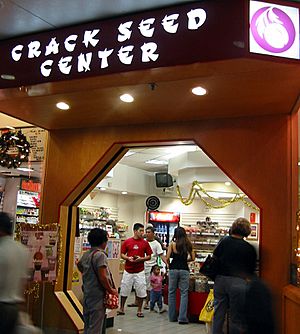Crack seed facts for kids

Imagine a super tasty snack made from fruit! That's what crack seed is. It's a special kind of preserved fruit that started in China. Today, it's super popular in places like Hawaii. The name "crack seed" comes from how the fruit is often cracked open. This lets the yummy flavors soak right into the seed inside.
Contents
What is Crack Seed?
Crack seed snacks are usually fruits that have been preserved. This means they are treated in a way that keeps them fresh for a long time. They can be dried, salted, or sweetened. The cool thing about crack seed is that the fruit is often split open. This helps the flavors get deep into the fruit and even the seed. It makes the snack extra delicious!
Where Did Crack Seed Come From?
This unique snack has a long history. It first came from China. In Chinese, it's often called see mui. In Hawaii, people sometimes say see moi. Crack seed arrived in Hawaii in the 1800s. This was when many Chinese immigrants came to work on big farms called plantations. Later, many Japanese workers also came to Hawaii. They liked crack seed too, because it was similar to their own snack called umeboshi.
What Does Crack Seed Taste Like?
Crack seed comes in so many different flavors! You can find ones that are super sweet, very salty, or even really sour. Some popular flavors include:
- Rock salt plum
- Honey mango
- Licorice peach
You can also find mixes of different fruits and flavors. The way they are preserved also changes the taste. What started as a simple preserved fruit is now a favorite snack in Hawaii. It's a great example of the different cultures that make up Hawaiian food.
Other Fun Crack Seed Snacks
Crack seed stores often sell more than just crack seed. They also have other candies that are given a special crack seed twist. For example, you might find:
These candies are often coated with a special powder called Li Hing Mui. This powder adds a unique sweet, sour, and salty taste.
Different Kinds of Crack Seed
There are many different types of crack seed. Some are dry and chewy. Others are soft and juicy. Here are a few examples you might find in Hawaii and Asia:
- Dry and chewy types of li hing mui
- Dried persimmons
- Preserved mandarin peels
- Salted Chinese and Thai olives, also known as nam liap in Thai

